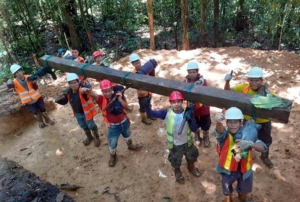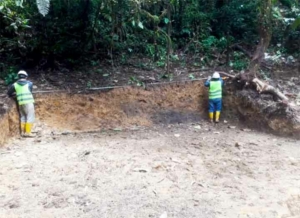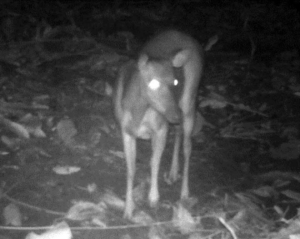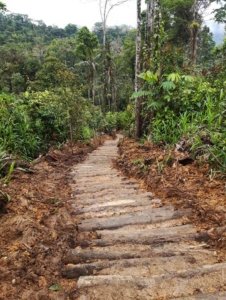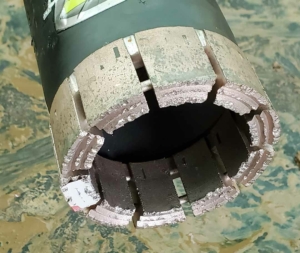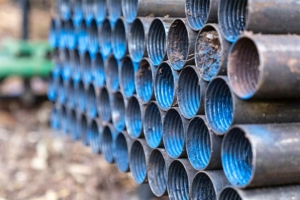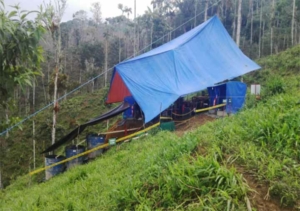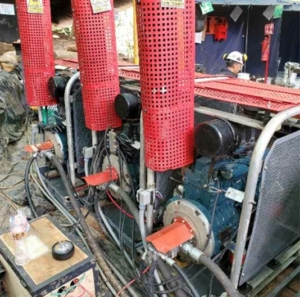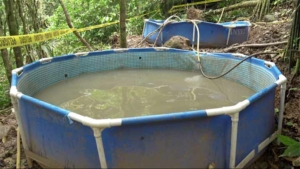Drill Site Preparation
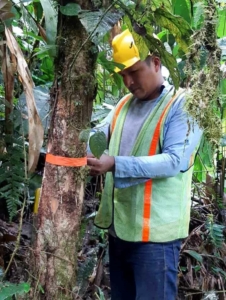
A community member measuring the diameter of a tree trunk in an area in which a drill pad is planned.
Baseline Species Studies – Once Aurania’s exploration team has identified a site from which they want to drill a target for gold, copper or silver-zinc, the environmental team moves in to do a count of species of fauna and flora with help from the local community. There are restrictions on the number of trees of certain diameters that can be felled for a platform. This often results in the platform being shifted slightly to fit between large trees. This “negotiation” as to a platform’s site requires tight communication between the exploration and environmental teams.
The platform for a scout drilling program can be up to 6 metres (18 feet) square. In the “Initial Exploration” phase, which is the phase that all of Aurania’s concessions are currently in, we are allowed up to 20 drill platforms per concession area. Aurania’s environmental management plan, which was approved by the Ministry of Environment and Water in 2019, allows us to cut trees over 10cm in diameter at each drill site. An environmental baseline study is done at each platform and involves recording and measuring the diameter of trees greater than 10cm in diameter. Other plant species are also counted. If endangered trees are encountered (these are typically those that are valuable for wood), the platform is shifted so that they do not have to be removed. Restoration will include seedlings of these trees if there is evidence of endangered species in the area.
Mist nets are used to survey bird and bat species, and traps are set for small mammals and reptiles. Once the species are recorded, the birds, mammals and reptiles are released back into the environment, outside of the immediate area of the platform.
Frogs are captured and injected with a small spot of dye that is detectable under ultraviolet light. This enables us to return to site after the drill platform has been restored to monitor the number of tagged frogs to assess the impact of the activity on these species. Finding the same number of frogs that were tagged would mean minimal environmental impact. Finding none would raise concern about our impacts and finding some tagged individuals is a good sign because we expect that some would have fallen prey to predators. Motion-triggered cameras are also set up to record the presence of larger animals.
During the environmental baseline study, seeds of the various species are collected by the local community for planting in the nursery where they are tended and then returned for the environmental restoration.
Any unidentified species are collected and delivered to the Ministry of the Environment and Water for further identification and cataloging. Reports on all of the above activities are delivered to the Ministry, which adds to the environmental database and understanding of the Project area.
No roads have been constructed for the drilling: the drills that we use are modular and can be moved by hand. Scout drilling at the first two sites (Crunchy Hill and Kuri-Yawi) were accessed from a paved road, while the drill rigs used to investigate other targets were transported to the general area by helicopter, and from there by hand. The access paths are allowed, as per Aurania’s environmental management plan, to be 1.5 metres (4 feet) wide, and are typically lined with wood exclusively cut from fallen tree trunks. The lining of the paths with tree trunks helps to minimize the development of deep mud and also protects the land from erosion.
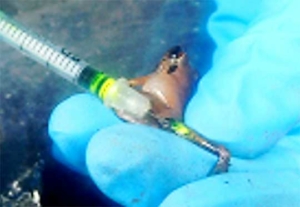
Frogs are injected with a tiny bit of dye that is visible in UV light, allowing the environmental team to return to the site later to count the marked individuals.






